Tourism in Scotland: the economic contribution of the sector
A report commissioned by the Tourism Leadership Group setting out economic data and trends on tourism across Scotland.
Chapter 3: The Tourism Sector in Scotland [14]

The SSE Hydro, Glasgow
3.1. The tourism sector is an important component of the Scottish Economy, supporting business activity and employment opportunities across all parts of Scotland.
3.2. The importance of tourism is demonstrated in its status as one of the Scottish Government’s six Growth Sectors – sectors in which Scotland has been identified as having a distinct comparative advantage. The other Growth Sectors are: Creative Industries, Energy, Financial & Business Services, Food & Drink, and Life Sciences.
3.3. There are differing approaches to defining the scope of Scotland’s tourism sector. For the purposes of this chapter, the industry is based on the Scottish Government’s ‘Sustainable Tourism Growth Sector’ definition, though it is recognised that this omits elements of the sector. A discussion of this is set out in Appendix 1.
Scotland’s Tourism Enterprises
3.4. In 2017, there were 14,145 registered enterprises within the Sustainable Tourism Growth Sector in Scotland. The sector accounted for 8 per cent of all registered businesses in Scotland.
3.5. Within the Sustainable Tourism Growth Sector, the largest sub-sector in terms of business numbers are restaurants (51 per cent), pubs and clubs (20 per cent) and hotels (11 per cent) [15] .
Infographic:
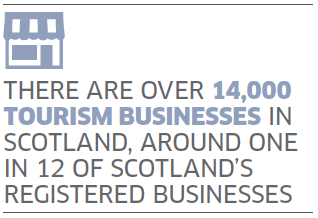
Infographic Text:
There Are Over 14,000 Tourism Businesses In Scotland, Around One In 12 Of Scotland’s Rgeistered Businesses
Chart 3: Registered businesses by size, 2017
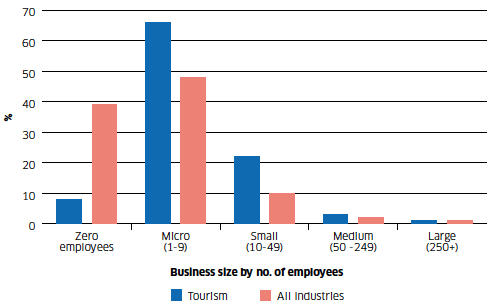
Sources: Scottish Government
3.6. Chart 3 above summarises the size distribution of the business base. While the market shares of medium and large businesses within the sustainable tourism sector are similar to the Scottish Economy as a whole, the sector has a notably larger share of micro-businesses (1-9 employees) and small businesses (10-49) than the Scottish Economy overall.
3.7. While 96 per cent of tourism enterprises are small (0-49 employees), they account for 51 per cent of employment in the sector. In contrast, large enterprises (250+ employees) account for just 1 per cent of registered enterprises and account for 34 per cent of employment in the sector.
3.8. The share of Tourism businesses within the overall business base varies across Scotland. Tourism related enterprises are over-represented relative to the national average in many rural areas: for instance, Argyll & Bute, and Highland, have the highest proportion of tourism businesses in Scotland as a share of their businesses bases. However, as Chart 4 below illustrates, it is not a uniform picture, as both Edinburgh and Glasgow also have a higher share of tourism businesses within their business bases than Scotland overall.
Chart 4: Tourism Businesses as a share of Businesses, by Local Authority, 2017
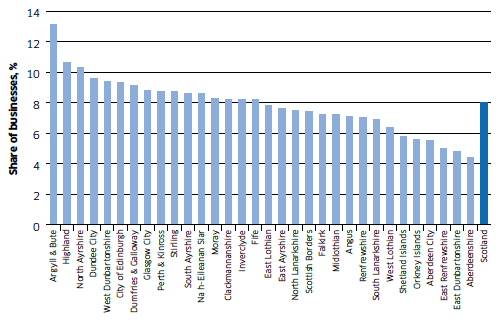
Sources: Scottish Government, Office for National Statistics (Inter Departmental Business Register)
Table 4: Total Turnover by Sustainable Tourism Sub-Sector (2015)
| Business Type | Total Turnover (£M) | % of total | % change, 2011-15, real terms |
|---|---|---|---|
| Restaurants | £2,481.5 | 36% | +15% |
| Hotels | £2,062.1 | 30% | +18% |
| Pubs & Clubs | £1,180.7 | 17% | -10% |
| Others | £1,212.3 | 17% | +20% |
| Sustainable Tourism Growth Sector | £6,936.6 | 100% | +11% |
Sources: Scottish Government (2018) Growth Sector Statistics Database; Scottish Annual Business Statistics
3.9. Overall turnover by Sustainable Tourism Growth Sector businesses has increased by 18 per cent since 2011, or 11 per cent in real terms. As Table 4 above illustrates, Restaurants (36 per cent), hotels (30 per cent) and pubs & clubs (17 per cent) account for the largest proportion of the Sustainable Tourism sector’s turnover. All sub-sectors, with the exception of pubs and clubs have seen an increase in turnover between 2011 and 2015.
3.10. A similar pattern is shown for GVA (Gross Value Added) which has increased by 32 per cent since 2011, or 25 per cent in real terms and driven largely by growth in the restaurant and hotel sectors. Sixty‑nine per cent of GVA can be attributed to restaurants and hotels.
3.11. As Chart 5 overleaf illustrates, almost one quarter (24.3 per cent) of the Sustainable Tourism Growth Sector’s GVA is generated by the City of Edinburgh. In addition to this, over one tenth (11.3 per cent) of the sector’s GVA is generated by Glasgow, 7.2 per cent by Aberdeen City and 5.2 per cent by Highland. Along with Fife, these five Local Authorities contribute more than half of the GVA in Scotland’s Sustainable Tourism Growth Sector as a whole.
Table 5: Gross Valued Added ( GVA) by Sustainable Tourism Sub-Sector (2015)
| Business Type | GVA (£m) | % of total | % change, 2011-15, real terms |
|---|---|---|---|
| Restaurants | £1,372.5 | 36% | +41% |
| Hotels | £1,227.8 | 33% | +25% |
| Pubs & Clubs | £636.0 | 17% | +11% |
| Others | £524.5 | 14% | +10% |
| Sustainable Tourism Growth Sector | £3,760.8 | 100% | +25% |
Sources: Scottish Government (2018) Growth Sector Statistics Database; Scottish Annual Business Statistics
Chart 5: Share of Sustainable Tourism Growth Sector GVA, 2015
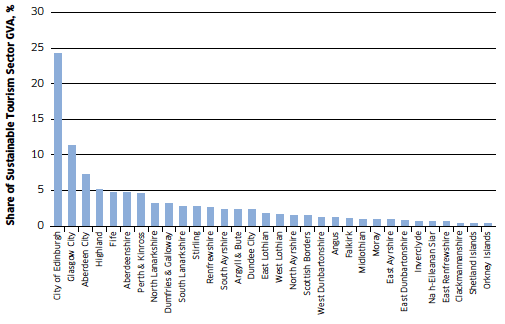
Sources: Scottish Government (2018) Growth Sector Statistics Database; Scottish Annual Business Statistics
3.12. To better understand the contribution of the Sustainable Tourism Growth Sector to local economies, it is helpful to consider the share of GVA within local areas that is attributable to the sector.
3.13. Figure 1 overleaf indicates the relative importance of the Sustainable Tourism Growth Sector to Scotland’s Local Authorities, in terms of its share of local GVA. The Local Authorities where the sector accounted for the highest share of local GVA were the Western Isles (10.9 per cent), City of Edinburgh (8.7 per cent), Argyll & Bute (8.4 per cent) and East Lothian (7.8 per cent).
Figure 1: Sustainable Tourism’s contribution to Local Authority GVA, 2015
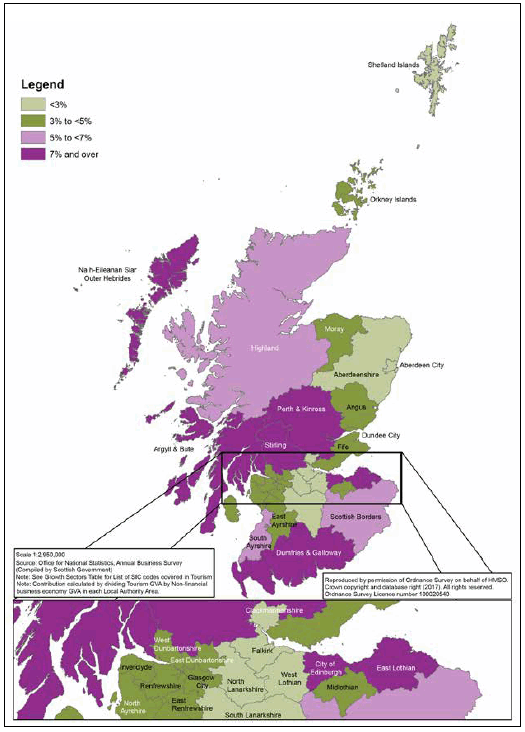
Sources: Scottish Government (2018) Growth Sector Statistics Database; Scottish Annual Business Statistics
Scotland’s Tourism Workforce
3.14. Scotland’s tourism sector is a significant employer across Scotland, and an important provider of routes into the labour market for a number of Scots.
3.15. In 2016, 207,000 people were employed in Scotland’s Sustainable Tourism Growth Sector [16] . This represents around 8 per cent of all employment in Scotland. Overall employment within the sector has increased by 12 per cent since 2011, creating an additional 20,000 jobs.
3.16. ust over half of the workforce within the sector are female, which is similar to the Scottish Economy as a whole. However, the sector has a notably higher proportion of part-time employment than the Scottish Economy overall, with 47 per cent of posts being part-time (compared against 27 per cent overall for Scotland), but a lower share of female employees in part-time roles (62 per cent, against 77 per cent for Scotland as a whole).
3.17. Within the sector, restaurants employ the most people, accounting for 39 per cent of all employment. The number of people employed in the restaurant sector has increased by 35 per cent since 2011, in contrast to the hotels and pubs & clubs sectors which have seen a decrease of 6 per cent and 10 per cent respectively.
Infographic:
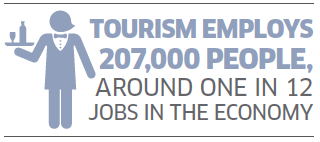
Infographic Text:
Tourism Employs 207,000 People, Around One In 12 Jobs In The Economy
Table 6: Employment by Sustainable Tourism Sub-Sector (2016)
| Business Type | Number of employees | % of total | % change 2011-16 |
|---|---|---|---|
| Restaurants | 81,000 | 39% | +35% |
| Hotels | 50,000 | 24% | -6% |
| Pubs & Clubs | 32,000 | 15% | -10% |
| Others | 44,000 | 22% | +22% |
| Sustainable Tourism | 207,000 | 100% | +12% |
Sources: Scottish Government (2018) Growth Sector Statistics Database; Scottish Annual Business Statistics
3.18. Some occupations represent a greater share compared with the Scottish Economy as a whole [17] :
- Around 14 per cent are managers, directors and senior officials, compared against 9 per cent for the Scottish Economy overall;
- Over 40 per cent are employed in elementary occupations (such as kitchen and catering assistants, waiters and waitresses, bar staff, leisure and theme park attendants, cleaning staff and hired help) compared against 11 per cent in the Scottish Economy overall;
- Over 14 per cent are employed in skilled trades (including chefs, catering and bar managers, groundsmen and greenkeepers) compared against 11 per cent in the Scottish Economy.
3.19. The sector also has a smaller share of staff in professional occupations (2 per cent) than the Scottish Economy overall (21 per cent).
3.20. While the share of the workforce educated to a degree level is lower in the Sustainable Tourism Growth Sector (17 per cent) than for the Scottish Economy overall (32 per cent), a larger portion of the work force are educated to Credit Standard Grade and Higher level (48 per cent) than the Scottish Economy (38 per cent).
3.21. Compared to the overall Scottish workforce, workers in the tourism sector are far less likely to be employed in occupations that are considered ‘High skill’ (4 per cent against 26 per cent in Scotland), and are more likely to be employed in occupations that are considered ‘Low skill’ (43 per cent against 11 per cent in Scotland). However, there is a larger concentration of workers in Medium-high skill roles than in Scotland as a whole, as shown in Table 7 below.
3.22 Despite this, the Hotels & Restaurants sector, which makes up part of the Sustainable Tourism Growth Sector, is more likely to report having underutilised or overqualified staff than most other sectors. In 2015, 41 per cent of Hotels and Restaurants reported having under-utilised staff, compared to 32 per cent across all sectors. 51 per cent reported having staff who were over-qualified for their role, compared to 42 per cent across all sectors [18] .
Table 7: Distribution of employment by Occupational Skill Level, 2017
| Sustainable Tourism Growth Sector (%) |
Scotland (%) | |
|---|---|---|
| High skill | % | 26% |
| Medium-high skill | 32% | 27% |
| Medium-low skill | 22% | 35% |
| Low skill | 43% | 11% |
Source: Annual Population Survey (Jan-Dec 2017)
3.23. Of those establishments with under-utilised staff, 46 per cent of businesses in the Hotels and Restaurants sector reported that the under-utilised staff were working in elementary roles, compared to just 9 per cent of over-qualified staff across all sectors. Around one quarter (26 per cent) of Hotels and Restaurants businesses stated that their under-utilised staff were not interested in taking on a higher level role, while one fifth (20 per cent) noted that the staff were using the job as a stop-gap until beginning their desired career.
3.24. The sector’s workforce has a high share of young workers, with around 59 per cent of the workforce aged between 16 and 34.
3.25. Non- UK nationals comprise a substantial proportion of the sector’s workforce. Box 2 below provides more detail on their importance to the sector.
Infographic:
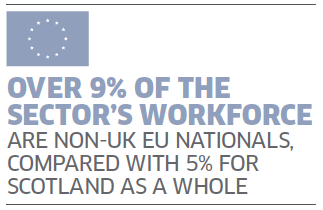
Infographic Text:
Over 9% Of The Sector’s Workforce Are Non-UK EU Nationals, Compared With 5% For Scotland As A Whole
Box 2: The Importance of Non- UK Nationals to Scotland’s Tourism Industry
Non- UK EU and non- EU nationals make a significant contribution to Scotland’s economy, and play a vital role in Scotland’s sustainable tourism sector.
In 2016, there were over 190,000 non- UK nationals living and working in Scotland, around two thirds of whom were EU nationals. Around 17,000 non- UK EU Nationals, and a further 5,000 non- EU nationals, were employed in the Sustainable Tourism Growth Sector. Table B2 below sets out how this compares against other industries identified by the Scottish Government as Growth Sectors.
Table B2: EU Nationals Employed in Scotland’s Growth Sectors, 2016
| Growth Sector | Non-UK EU Nationals Employed | Share of Non-UK EU Nationals in Employment | Share of Employment in Sector |
|---|---|---|---|
| Sustainable Tourism | 17,000 | 13.2% | 9.4% |
| Food & Drink | 10,000 | 7.7% | 12.3% |
| Creative Industries | 10,000 | 8.1% | 7.6% |
| Finance & Business Services | 9,000 | 7.1% | 4.2% |
| Scotland | 128,000 | 100% | 5.0% |
Source: APS, Jan-Dec 2016, ONS
Table B2 shows the sector to be the largest employer of EU nationals among the growth sectors. Over 9 per cent of the Sustainable Tourism sector’s workforce were non- UK EU nationals – almost double the share for the economy as a whole. A further 3 per cent of the sector’s workforce are non- EU nationals. Within the Hotels sector, this share is higher, with 15 per cent of employees coming from outside the UK. This illustrates the importance of workers from outside the UK to the success of the sector.
Earnings and the Gender Pay Gap [19]
3.26. Earnings within the Sustainable Tourism sector tend to be lower than those in some other parts of the Scottish Economy. In 2017, median weekly full time earnings across the Scottish Sustainable Tourism growth sector stood at £357. This was lower than the equivalent for the Scottish Economy as a whole, which stood at £547 in 2017. This measure had also grown more slowly for the sector than in the Scottish Economy overall during 2017, with median weekly full time earnings increasing by 1.6 per cent and 2.4 per cent respectively.
3.27. The proportion of employees earning the Living Wage is also lower within the Sustainable Tourism Growth Sector than the overall Scottish Economy. In 2017, 40 per cent of employees in Scotland’s sustainable tourism sector earned the Living Wage or more, compared with almost 82 per cent of all Scottish employees aged 18 and over.
3.28. However, the Sustainable Tourism Growth Sector performed more favourably than the Scottish Economy overall with regard to gender disparities in pay. In 2017, the gender pay gap within the sustainable tourism sector was 2.7 per cent, compared with 6.6 per cent for Scotland overall.
Regional Employment In Tourism
3.29. Tourism employs people the length and breadth of the country. Although heavily represented within Scotland’s largest cities, the sector is also an important provider of employment on Scotland’s more rural and coastal regions.
3.30. In 2016, five local authority areas account for almost half of employment in the sustainable tourism workforce, while around 30 per cent of employment in the sector was concentrated in the City of Edinburgh (15.9 per cent) and Glasgow City (14 per cent) combined. Highland, Fife and Aberdeen City employed a further 7.7 per cent, 5.3 per cent and 4.8 per cent of the sustainable tourism sector workforce respectively. Figure 2 overleaf shows the share of tourism employment across Scotland.
3.31. However, several local authority areas are more dependent on tourism employment than the Scottish average. For instance, tourism represents 15 per cent of total employment in Argyll and Bute, and 13 per cent in both Perth & Kinross and Highland.
3.32. A number of Scottish local authority areas also rely more heavily on tourism as an employer than the Scottish Economy overall. For instance, the share of employment in the sustainable tourism sector is over 30 per cent higher in Argyll and Bute, the Highlands, Perth and Kinross, South Ayrshire and East Lothian than the Scottish Economy overall. Edinburgh, Stirling, the Borders, and Dumfries and Galloway also have a relatively higher reliance on the sector for employment than the Scottish Economy overall, as is illustrated in Figure 3 [20] on page 24.
Figure 2: The Share of Tourism Employment in Scotland, by Local Authority, 2016
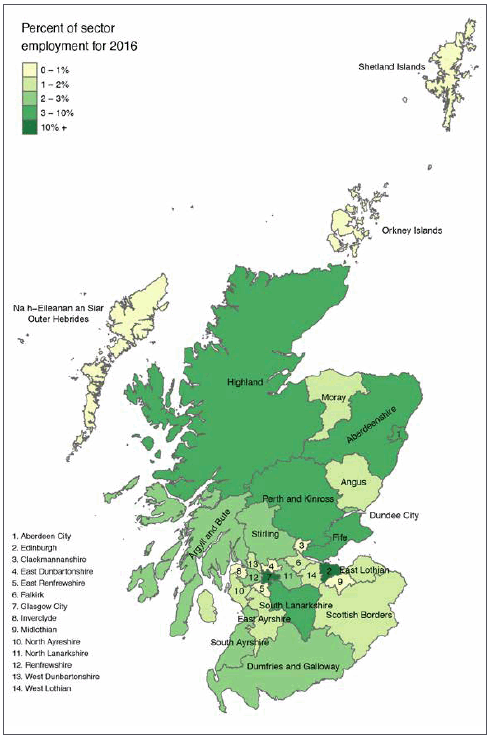
Source: Scottish Government, Business Register and Employment Survey 2016
Figure 3: Importance of Sustainable Tourism Employment, Compared to Scottish Average, 2016
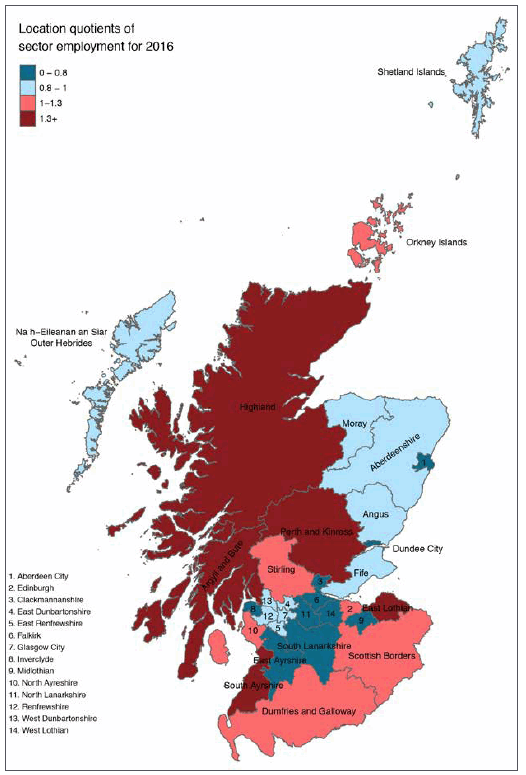
3.33. Tourism is also an important employer in Scotland’s rural areas. For instance, in 2016, 14 per cent of jobs in ‘remote rural’ [21] areas were in the accommodation and food service sectors. This meant the sector was third only to the public sector (16 per cent) and agriculture, forestry and fishing (15 per cent) [22] in terms of employment in these areas.
Benchmarking the Tourism Sector against other Scottish Government Growth Sectors
3.34. As mentioned earlier in paragraph 3.2, Sustainable Tourism is one of six growth sectors identified by the Scottish Government in which Scotland has been identified as having a distinct comparative advantage. Table 8 below compares the different growth sectors’ performance against a range of economic indicators.
3.35. These results highlight some of the differences between tourism and the other growth sectors. The Sustainable Tourism Growth Sector is the second-largest sector, in terms of employment. However, it also has the lowest productivity level (in terms of GVA/worker). This reflects the labour-intensive and people-orientated nature of many occupations within the tourism sector, and also reflects the relatively high share of part-time employees.
3.36. When comparing the Growth Sectors, it is also important to consider changes in performance over time. Since 2011, productivity levels in the sector have grown by over 5 per cent in real terms, while employment has also grown by 12 per cent.
Table 8: Scottish Government Growth Sectors, Economic Measures [23]
| Sector | Enterprises (2017) | Employment (2016) | Exports (£M, 2016) | Productivity ( GVA/worker, 2015) |
|---|---|---|---|---|
| Scotland Overall | 176,400 | 2,588,000 | £75,580 | £49,708 |
| Food and Drink | 17,330 | 111,000 | £10,145 | £45,309 |
| Financial & Business Services | 28,985 | 232,000 | £13,220 | n/a |
| Life Sciences | 540 | 16,000 | £1,310 | £77,281 |
| Energy | 3,920 | 70,000 | £13,870 | £223,359 |
| Sustainable Tourism | 14,145 | 207,000 | £900 | £17,771 |
| Creative Industries | 15,735 | 84,000 | £2,915 | £68,062 |
Sources: Growth Sector Statistics Database; Scottish Annual Business Statistics
Chart 6: Growth Sectors, Change in Productivity and Employment since 2011 [24]
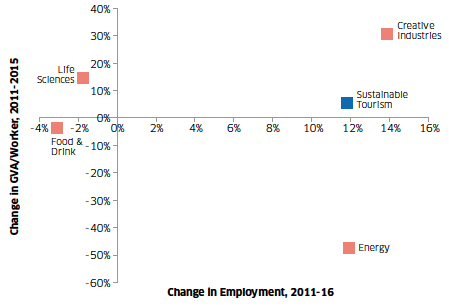
3.37. As Chart 6 highlights that the Sustainable Tourism sector and the Creative Industries both contributed to productivity and employment growth since 2011. The other growth sectors for which comparable data is available either experienced growth in employment or in productivity.
Summary
3.38. The Tourism sector represents both an important part of the Scottish business base, and an important source of employment across Scotland. While the sector represents an important part of the economies of Scotland’s cities, it also forms a critical part of the economies of more rural areas like the Highlands and Argyll and Bute.
3.39. The sector is an important source of flexible employment and employment for young people, and has benefited in recent years from the contribution of Non- EU nationals. The sector has also been an important source of both employment and productivity growth since 2011. The contribution that the sector makes to Scotland’s economy overall is discussed further in Chapter 4.
Contact
There is a problem
Thanks for your feedback